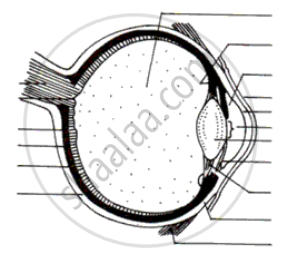Advertisements
Advertisements
प्रश्न
Differentiate between:
Yellow spot and Blind spot.
उत्तर
| Yellow Spot | Blind Spot |
| (i) It has only cone cells. | It has neither cone cells nor rod cells. |
| (ii) Clear images are formed here. | No images are formed here. |
APPEARS IN
संबंधित प्रश्न
Differentiate between: Rods and cones
The optical prescription for a pair of spectacles is :
Right eye : −3.50 D
Left eye : −4.00 D
Are these lenses thinner at the middle or at the edges?
Name the part of the eye:
on which the image is formed.
Out of rods and cones m the retina of your eye:
which detect colour?
What do the ciliary muscles do when you are focusing on a nearby object?
Fill in the following blank with suitable word:
The part of eye which alters the size of the pupil is............
If you walk from a dark room into sunlight and back again into dark room, how would your pupils alter in size? What makes this happen?
What are the advantages of having two eyes instead of just one?
With both eyes open, a person's field of view is about:
(a) 90°
(b) 150°
(c) 180°
(d) 360°
State the function of each of the following parts of the human eye:
(i) Cornea
(ii) Iris
(iii) Pupil
(iv) Retina
Millions of people of the developing countries are suffering from corneal blindness. This disease can be cured by replacing the defective cornea with the cornea of a donated eye. Your school has organised a campaign in the school and its neighbourhood in order to create awareness about this fact and motivate people to donate their eyes after death. How can you along with your classmates contribute in this noble cause? State the objectives of organising such campaigns in schools.
Name the following:
White part of the eye.
Define the following:
Power of accommodation
Label the following diagram :

Give the main function of the following:
Three semicircular canals
Choose the correct answer.
Colour is detected by ____________
Draw a diagram of the human eye as seen in a vertical section and label the parts which suit the following descriptions relating to the:
(i) photosensitive layer of the eye.
(ii) structure which is responsible for holding the eye lens in its position.
(iii) structure which maintains the shape of the eyeball and the area of no vision.
(iv) anterior chamber seen in front of the eye lens.
(v) outermost transparent layer seen in front of the eyeball.
Explain the Term: Accommodation in the eye
Draw a scientifically correct labelled diagram of a human eye and answer the questions based on it:
- Name the type of lens in the human eye.
- Name the screen at which the maximum amount of incident light is refracted?
- State the nature of the image formed of the object on the screen inside the eye.
The pigmented circular area seen in front of the eye:
In the figure of the human eye, the cornea is represented by the letter

